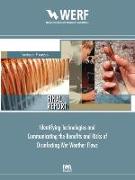- Start
- Identifying Technologies and Communicating the Benefits and Risks of Disinfecting Wet Weather Flows
Identifying Technologies and Communicating the Benefits and Risks of Disinfecting Wet Weather Flows
Angebote / Angebote:
The primary objective of this project was to identify and communicate the benefits and risks of disinfecting wet weather flows by evaluating available disinfection technologies and identifying disinfection by-products and their potential risks to aquatic and human life. A decision-making framework was developed that could be used as a model to guide combined sewer overflow (CSO), sanitary sewer overflow (SSO) and stormwater (SW) disinfection control policies. This project was implemented as a case study in collaboration with the Onondaga County Department of Water Environment Protection (Syracuse, NY). A literature review was completed that identified appropriate disinfection technologies and the associated disinfection by-products. A disinfection demonstration was conducted to verify findings of the literature review and fill data gaps. The data collected during this project were used by local stakeholders to select the most appropriate technologies. Information regarding the benefits and risks of disinfecting wet weather flows was also presented to the public during a public workshop. All four technologies that were piloted achieved the United States Environmental Protection Agency's bacterial criteria. Ozonation and UV produced no measurable residuals or by-products and resulted in no effluent aquatic toxicity as measured through WET testing. Chlorination/dechlorination and chlorine dioxide did produce residuals and disinfection by-products including chlorate, chlorite, trihalomethanes and haloacetic acids. With the exception of chlorite, these by-product concentrations were less than drinking water standards. Chlorination/dechlorination and chlorine dioxide did result in effluent aquatic toxicity as measured through WET testing. In the case of chlorination/dechlorination the toxicity appeared to be related to residual chlorine and in the case of chlorine dioxide the toxicity appeared to be related to residual chlorine dioxide and/or chlorite. Residuals can easily be controlled through proper dechlorination in a full-scale application. The chlorite was a by-product of the particular chlorine dioxide production method, this could be avoided by a generation method that produces a chlorite-free product, which would be more appropriate for a full-scale application. Based on findings from the literature review and disinfection demonstration, hazards associated with wet weather flow disinfection appear low, but the potential for public opposition can be high. Therefore, proper communication planning to include stakeholders in the decision-making process and conduct public outreach is required. Stakeholders were included throughout the project through workshops.
Folgt in ca. 15 Arbeitstagen
